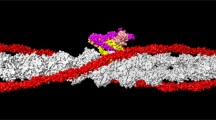Abstract
(1) Single twitch fibres were dissected from tibialis muscles ofRana temporaria and used to study the effect of D600 (gallopamil) on potassium-induced contractures. (2) 95 mM K-Ringer's was applied for 8–15 s at intervals of generally 2.5–5 min; at temperatures of 6–8°C and in the absence of D600 the amplitude of the contractures remained fairly constant. After pretreatment with D600 (30 μM) a single (conditioning) K-contracture was sufficient to ‘paralyze’ the fibres (cf. Eisenberg et al. 1983). (3) Complete paralysis could also be achieved at 18–20°C. In three fibres a single conditioning K-application was sufficient; in two more fibres two or three conditioning K-applications were required. (4) D600-paralysis could not only be achieved with high K-concentrations but also by conditioning with subor suprathreshold K-concentrations (20–40 mM); the duration of the conditioning periods required to induce complete paralysis was approximately the same before and after D600-treatment. (5) Contractures were partially abolished by application of 20–40 mM K-Ringer's for short conditioning periods; after D600-treatment the degree of contracture loss was similar.
(6) At low temperature the state of partial or complete paralysis induced by subthreshold K-concentrations and D600 was maintained for long periods of time. (7) The presence of 10 mM Ca2+ did not protect the fibres from being paralyzed by treatment with D600 and high K-Ringer's at low temperature; however, more than one conditioning K-application was required. (8) Resting and action potentials of paralyzed fibres were not significantly different from control values. However, endplate potentials were reduced in size, and failure of neuromuscular transmission was observed in some of these fibres. (9) It is concluded that D600 prolongs the state of inactivation of the contractile mechanism, while the development of inactivation does not seem to be markedly affected.
Similar content being viewed by others
References
Adrian H, Chandler WK, Rakowski RF (1976) Charge movement and mechanical repriming in skeletal muscle. J Physiol 254:361–388
Almers W, Fink R, Palade PT (1981) Calcium depletion in frog muscle tubulus: the decline of calcium current under maintained depolarization. J Physiol 312:177–207
Almers W, McCleskey EW, Palade PT (1985) Calcium channels in vertebrate skeletal muscle. In: Rubin RP, Weiss GB, Putney W jr (eds) Calcium in biological systems. Plenum Publishing Corporation, New York, London
Bregestovski PD, Miledi R, Parker I (1980) Blocking of frog endplate channels by the organic calcium antagonist D600. Proc R Soc Lond Biol 211:15–24
Caputo C (1972) The effect of low temperature on the excitation-contraction coupling phenomena of frog single muscle fibres. J Physiol 223:461–482
Chandler WK, Rakowski RF, Schneider MF (1976) Effects of glycerol treatment and maintained depolarization on charge movement in skeletal muscle. J Physiol 254:285–316
Curtis BA, Eisenberg RS (1985) Calcium influx in contracting and paralyzed frog twitch muscle fibres. J Gen Physiol 85:383–408
Eisenberg RS, McCarthy RT, Milton RL (1983) Paralysis of frog skeletal muscle fibres by the calcium antagonist D600. J Physiol 341:495–505
Fatt P, Katz B (1951) An analysis of the end-plate potential recorded with an intracellular electrode. J Physiol 115:320–370
Fill MD, Best PM (1986) Contracture of skinned skeletal muscle fibers induced by ionic substitution: Comparison of block by D600 and Nitrendipine. Biophys J 49:13a
Frankenhaeuser B, Lännergren J (1967) The effect of calcium on the mechanical response of single twitch muscle fibres ofXenopus laevis. Acta Physiol Scand 69:242–254
Hodgkin AL, Horowicz P (1959) The influence of potassium and chloride on the membrane potential of single muscle fibres. J Physiol 148:127–160
Hodgkin AL, Horowicz P (1960) Potassium contractures in single muscle fibres. J Physiol 153:386–403
Huerta M, Stefani E (1981) Potassium and caffeine contractures in fast and slow muscles of the chicken. J Physiol 318:181–189
Hui CS, Milton RL, Eisenberg RS (1984) Charge movement in skeletal muscle fibers paralyzed by the calcium-entry blocker D600. Proc Natl Acad Sci USA 81:2582–2585
Ildefonse M, Jacquemond V, Rougier O, Renaud JF, Fosset M, Lazdunski M (1985) Excitation contraction coupling in skeletal muscle: Evidence for a role of slow Ca2+ channels using Ca2+ channel activators and inhibitors in the dihydropyridine series. Biochem Biophys Res Commun 129:904–909
Lehmann N, Schmidt H (1979) Contractile responses to direct stimulation of frog slow muscle fibres before and after denervation. Pflügers Arch 382:43–50
Lorković H (1961) Inhibition by potassium of the mechanical responses of frog muscles at low temperature. Nature 191:1011–1012
Lorković H, Rüdel R (1983) Influence of divalent cations on potassium contracture duration in frog muscle fibres. Pflügers Arch 398:114–119
Lüttgau HCh (1963) The action of calcium ions on potassium contractures of single muscle fibres. J Physiol 168:679–697
Lüttgau HCh, Spiecker W (1979) The effects of calcium deprivation upon mechanical and electrophysiological parameters in skeletal muscle fibres of the frog. J Physiol 296:411–429
McCleskey EW (1985) Calcium channels and intracellular calcium release are pharmacologically different in frog skeletal muscle. J Physiol 361:231–249
Sanchez JA, Stefani E (1978) Inward calcium current in twitch muscle fibres of the frog. J Physiol 283:197–209
Siebler M, Schmidt H (1985) Experiments on the mechanism of D600-paralysis in twitch fibres ofRana temporaria. Pflügers Arch 405:(Suppl):R59
Stuesse SC, Lindley BD (1975) Contractile inactivation in frog single denervated muscle fibers. Am J Physiol 229:1492–1497
Author information
Authors and Affiliations
Rights and permissions
About this article
Cite this article
Siebler, M., Schmidt, H. D600 prolongs inactivation of the contractile system in frog twitch fibres. Pflugers Arch. 410, 75–82 (1987). https://doi.org/10.1007/BF00581899
Received:
Accepted:
Issue Date:
DOI: https://doi.org/10.1007/BF00581899




